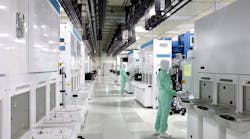In the latest feud with its American counterpart, Toshiba said that it would continue building its newest fab alone, effectively cutting Western Digital from its supply of 3D NAND memory chips. Western Digital said it won’t let that happen.
The companies have been trading barbs for months since Toshiba announced the sale of its memory business to offset devastating losses in its nuclear power unit. Western Digital claims final say on the fate of the Japanese memory chip maker because it partially owns the new Yokkaichi plant.
Western Digital inherited the Fab 6 investment when it bought SanDisk, whose partnership with Toshiba started in 2001. But the Tokyo-based company denies that the joint venture affords Western Digital special rights. And its patience seems to be wearing thin.
“Toshiba is dismayed by Western Digital’s pattern of exaggerating SanDisk’s right under the relevant agreements,” the company said in a statement on Friday. “Despite claims to the contrary, Western Digital does not now possess any legal ‘rights’ to participate in this phase of investment, which is an important investment in the next generation of flash memory.”
Western Digital disagreed, saying in a statement shortly after that its “legal rights are clear, and we remain confident that we will receive out share of any capacity from Fab 6.” The company, based in San Jose, Calif., also said that it would continue its “constructive dialogue with Toshiba on this and other matters.”
These negotiations have gone in and out of court for months. On Friday, Western Digital said that a judge had ordered Toshiba to resume sending it wafers and other engineering samples. The ruling also nullified a restraining order that prohibited Western Digital employees from viewing databases shared with Toshiba.
Throughout the quarrel, Toshiba has argued that Western Digital is overstepping its rights. So far, the company has fielded bids from a corporate coalition including Foxconn and Apple. But it prefers to sell its memory chip business to a Japanese consortium led by the government, which placed an $18 billion bid that Western Digital has opposed.
Toshiba’s memory unit is seen as the crown jewel of Japan's industrial giant, which sells everything from televisions to electric transformers. Almost four decades ago, Toshiba pioneered the NAND flash chips now vital to smartphones and personal computers and increasingly data centers and factory equipment. It holds a fifth of the global market, second to Samsung.
Toshiba also has the manufacturing might that has become key to success in the memory market. Losing capacity could significantly hurt Western Digital now that the recent shortage of short-term memory and long-term storage has sent prices soaring. Western Digital has submitted its own bids for Toshiba’s chip unit.
With everything at stake, Toshiba’s talks with Western Digital have been bumpy. Toshiba said that it had negotiated with its American partner over Fab 6 for months. Production is scheduled to start in the middle of next year. It will carefully fabricate advanced 3D NAND chips with 96 layers.
“Toshiba provided an investment proposal to SanDisk earlier this year,” Toshiba said in its statement on Friday. “Despite numerous meetings and negotiations, including at the CEO to CEO level, Toshiba’s proposal was not accepted on the timetable set out in the agreements.”
As a result, Toshiba said that it would alone pay 195 billion yen (around $1.76 billion) for clean room equipment that can sandwich memory up to 96 layers. It is Toshiba’s attempt to cut off Western Digital from the chips produced on the new technology. Installation could start as early as December.

